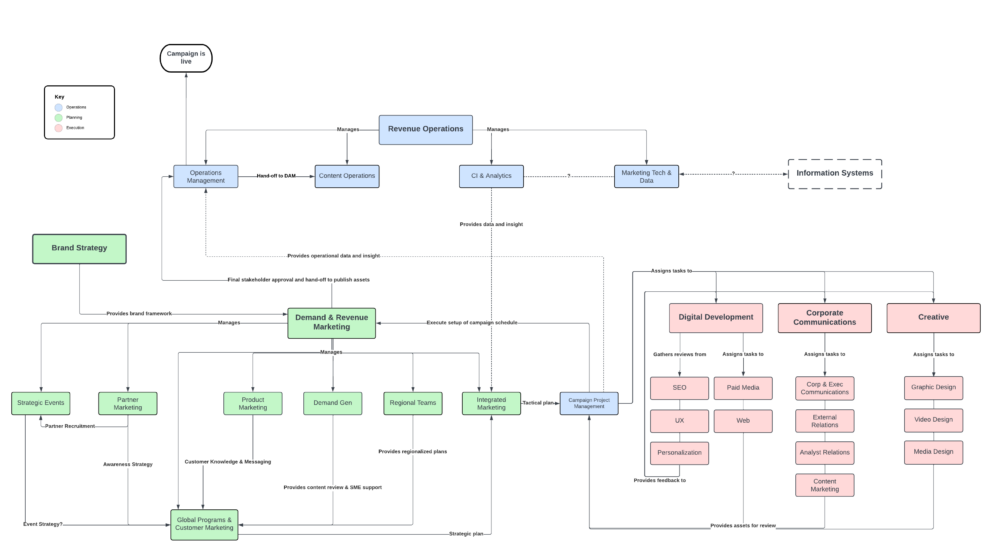By: Tom Swanson, Senior Engagement Manager at Heinz Marketing
In my recent post (5 common CMO questions about marketing orchestration), I said one of the best things you can do to improve your orchestration is hire project managers. Well my thinking on that… hasn’t changed!
PMs are arguably the most important role in the orchestration needs of anything, but marketing is especially in need. The problem is that since PMing is an investment that doesn’t directly produce revenue, it can be a tough sell.
That is usually because folks aren’t accustomed to seeing PMs in marketing teams. While I am a firm believer in a PM being key the moment you start producing content and campaigns, there are some teams with greater need. If you are a 25+ person team with multiple cross-functional groups, for example. If you have multiple GTM motions, product groups, or any time at all you have an internal creative resource servicing requests from multiple teams.
To further drive the point home, here are some reasons marketing teams should really consider hiring some PMs:
- CEO to Engineer, everyone has a ton of ideas about how they would do marketing right. PMs can help filter and direct this in productive ways or divert it entirely.
- Most marketing efforts change hands multiple times. PMs are necessary to facilitate this.
- Project management tool usage is difficult to get consistent. Improving this is a core remit and success metric for PMs.
- Without consistent, owned time tracking then SLAs will be nearly impossible to get accurate.
There are many more reasons. To put it frankly, if great PMs can get projects done in spite of bad organization, imagine what they can do in well-orchestrated efforts.
Just like any other function, PMing needs to be supported properly to make sure you get the most out of it. Here are the 5 biggest things to consider when designing how PMs should operate within a marketing team.
As an added bonus, at the bottom I have some questions for you to help you figure out where to start.
Impact on Accountability
One of the biggest roles of a PM is to hold the line about process. Unfortunately, many PMs can’t really hold accountability to process because they aren’t the manager of the individual contributors. If the leadership on each team isn’t willing to support the PM in holding their direct reports accountable, then the PM process cannot be feasibly enforced by the PM.
If you are going to bring in a PM, all of the team leads need to be on board with the process, how it works, and why it matters. They should take PM feedback and requests seriously.
A good example of when this goes wrong: PM tool usage. Most PM tools are supposed to be center points of communication. Yet inevitably conversations happen elsewhere and are never logged, comments are mad-houses, and the rigidity of the tool yields lost updates if things go awry.
PMs should be maintaining these project boards as they grow and evolve. Like a bonsai tree, projects and steps will need to be intentionally developed and pruned as they go and the ground shifts beneath them.
Marketing’s inherent unpredictability requires the finesse and flexibility that only a PM can provide.
Boundaries
We all love boundaries, until they get in our way. Yet boundaries are crucial to the wellbeing of the team and quality of the work. PMs need to have the power to hold the boundaries when appropriate and escalate when needed.

RACI’s can help define boundaries
Sometimes priorities shift, and often this kills marketing efforts quickly. Yet, if there is a process for handling that, then PMs can make sure things are kept shipshape even in the face of change.
At one client, we were tasked with developing a prioritization model for marketing work. We did, basing it on one leadership-subjective field and three objective ones. The key to the efficacy of this tool was that PMs were empowered to lead this prioritization process. This included going to leadership and facilitating their discussion around the subjective field (which was often the tiebreaker of the objective fields).
The result was clarity around what teams should be working on, and an accepted process for prioritization shifts.
The bonus of this is that the PMs were able to articulate the consequences of changing a priority. This means that leadership made informed and committed decisions, making life much easier for the creative teams.
Power over process
Since PM’s live the process, they should be the owners of the process. What are the steps? Which ones are necessary? What redundancy can be removed? How can persistent bottlenecks be designed out?
These are all important questions that can sink a workflow if not dealt with, over and over again. The work of optimizing a process is never done, especially as teams grow and scale.
Typically this is done through retrospectives at the end of specific projects. Here is how we built it at a client:
During projects, PMs would use the risk-management function of Adobe Workfront. They would log project risks and categorize them but an accepted group of standard categories. These are reviewed at the end of the project, and on a quarterly basis by the project management office (PMO).
Consistent risks to projects indicate a pattern that can be changed/adjusted. This process brings together data from across projects so that templates, workflows, and roles can all be refined for the organization as a whole.
Reporting to Ops
While you might have PMs that serve specific teams or functions, all PMs should report to marketing operations. This third party accountability is key to PMs being able to do their jobs effectively. They need to look across functions at how teams work together, so having them report in one of those teams creates unnecessary myopy.

PMs are in blue and report to Ops in our standard ecosystem.
The above points are all extremely important to this one being successful. Operations and the various team leads need to have a great mutual respect and a firm commitment to boundaries. If they don’t, then PMs won’t have the sway to be effective, and you will wind up with a workflow plagued by work-arounds and process breaches.
Managing the Change
If you are looking for where to start, I recommend taking an honest, candid look at your team. Ask yourself a few key questions:
- Do your teams have trust in one another?
- Are they willing to all commit to a process?
- Are you currently undergoing change efforts?
- Do you have a PM tool at least somewhat adopted?
- Is it clear who is accountable to a project’s success?
- Can you succinctly describe what that success looks like?
If you answered no to any of those, that is likely a better place to start than hiring a PM. I am not saying you wouldn’t get any benefit, you would. Like I said earlier, a great PM can operate in spite of bad organization. However, if they are coming into a solid foundation, they will accelerate and improve considerably faster.
You can also check out this post on how to tell when it is time to improve your marketing orchestration.
I am here to talk to you about your orchestration. Feel free to reach out to us. You can even ask to speak to me directly, I would love to chat.
If you are looking for more ways to improve, check out “B2B Excellence through Marketing Orchestration“.
The post Structuring Project Management in a Marketing Team appeared first on Heinz Marketing.








